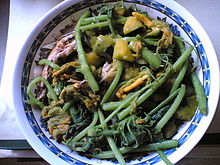Dinengdeng
 Dinengdeng consisting of calabaza squash, shoots and blossoms, and grilled fish. | |
| Alternative names | Inabraw |
|---|---|
| Course | Main course |
| Place of origin | Philippines |
| Region or state | Northern Philippines |
| Associated cuisine | Filipino cuisine |
| Serving temperature | Hot |
| Main ingredients | Bagoong, vegetables, fish, meat |
| Variations | Buridibod, sari sari |
| Similar dishes | Pinakbet |
Dinengdeng (also called inabraw) is a dish of the Ilocano people of the Philippines, similar to pinakbet.[1] It is classified as a bagoong (fermented fish sauce) soup-based dish. Unlike pinakbet, dinengdeng contains fewer vegetables more soup base.[2]
A simple meal to prepare was necessary for the Ilocano, who often labored in labor-intensive agriculture industries. Another characteristic of Ilocano cuisine is that dishes are either salty or bitter which means dishes that went well with rice. Dinengdeng, like its more festal sibling pinakbet, is a dish best enjoyed with rice. However, because dinengdeng requires fewer ingredients, it is able to be prepared daily.[3]
Vegetables
Many of these vegetables are easily accessible and are grown in backyards and gardens of most Ilocano households. The dish may contain a numerous combination of the following vegetables:[4][5]
- Aba (taro), corms
- Alukon (Broussonetia luzonica), blossoms
- Balangkoy (cassava), tubers
- Balatong (mung beans), dried beans
- Bukel ti otong (black-eyed peas), dried beans
- Daludal (taro), shoots
- Kabatiti (luffa), gourd
- Kalunay (amaranth), leaves
- Kamotig (sweet potato), tubers and leaves
- Karabasa (calabaza), squash, blossoms, young shoots
- Kardis (pigeon pea), shelled beans
- Katuday (West-Indian pea), shelled beans
- Kutsay (garlic chives), leaves
- Mais (sweet corn), cobs
- Marunggay (moringa), leaves and pods
- Okra (okra), fruit
- Otong (black-eyed peas), young pods
- Otong (snakebeans), young pods
- Pallang (winged bean), fruit
- Parda (parda bean), young pods
- Parya (bittermelon), leaves and unripe fruit
- Patani (lima beans), shelled beans
- Rabanos (rat-tail radish), pods
- Rabong (bamboo shoots), shoots
- Sabunganay (banana), blossoms
- Saluyot (jute), leaves
- Sayote (chayote), fruit and young shoots
- Sili (chili peppers), leaves and unripe fruits
- Tabungaw (bottle gourd), gourd
- Talilong (Talinum), shoots
- Tangkoy (winter melon), gourd
- Tarong (eggplant), fruit
- Tugi (yams), and wild potatoes
- Uong (mushrooms)
Variations
In variations where kamotig (sweet potato tubers) are featured as a main ingredient, it is called buridibod. The sweet potato tubers may sometimes be cooked to the point where it disintegrates creating a thicker soup.[8][9]
In Hawaii, despite the
In popular culture
Dinengdeng Festival
The annual "Dinengdeng Festival" is the official festive event of the municipality of Agoo, La Union, Philippines held in the summer.[13][14] The festival is held in celebration of the dish and to promote tourism. A large banga (clay pot) is used symbolize the festival, called the "Big Banga". It is used during the event in cooking the dinengdeng.
This festival replaces the old theme of tobacco, an important agricultural crop of Agoo. However, tobacco festivals are commonly celebrated throughout the country in different towns.[15] The goal of the local government desired this festival to be comparable to other prominent festivities in the region, such as the Panagbenga.[16]
See also
References
- S2CID 41934520.)
{{cite journal}}: CS1 maint: multiple names: authors list (link - ISBN 978-0-8248-2582-9. Retrieved March 24, 2013.
- ^ "A Taste of Ilocos Norte". Museo Ilocos Norte. December 9, 2008.
- ^ "Agoo lays out 1-km long table for festival's 'dinengdeng'". mb.com.ph. Archived from the original on November 21, 2015. Retrieved November 21, 2015.
- ^ Maghirang, Rodel G., Oraye, C. D., Antonio, M. A., Cacal, M. S., & City, B (2018). Ethnobotanical studies of some plants commonly used as vegetables in selected provinces of the Philippines. J Nat Stud. 17 (2). pp. 30–43.
{{cite book}}: CS1 maint: multiple names: authors list (link) - ^ Gascon, Helen C., Kathryn J. Orr (2018). About FIlipino Foods.
- S2CID 238395052.)
{{cite journal}}: CS1 maint: multiple names: authors list (link - ^ "Buridibud". Ang Sarap. April 22, 2015. Retrieved October 7, 2023.
- ^ "Buridibud Ilocano Vegetable Recipe". Overseas Pinoy Cooking. Retrieved October 7, 2023.
- ^ Adams, Wanda A. (May 17, 2006). "Try a simply elegant blanched salad or savory sari-sari stew | The Honolulu Advertiser | Hawaii's Newspaper". the.honoluluadvertiser.com. Retrieved October 18, 2023.
- ^ Tabura, Lanai (August 20, 2014). "Sari Sari — Shaken, Not Stirred - Elena's". MidWeek. Retrieved October 18, 2023.
- ^ "Elena's Home of Finest Filipino Foods – Serving the Finest Filipino Food in Hawai'i for over 40 Years". elenasrestaurant.com. Retrieved October 16, 2023.
- ^ "10th Agoo Dinengdeng Festival". www.launion.gov.ph. Retrieved February 28, 2015.
- ^ "AGOO DINENGDENG FESTIVAL". Dept. of Tourism, Agoo, La Union. Retrieved February 28, 2015.
- ^ "Dinengdeng Festival in La Union". ABS-CBN News and Current Affairs. Retrieved February 28, 2015.
- ^ "5 Things About Agoo's Dinengdeng Festival". doonposaamin.ph. Archived from the original on April 2, 2015. Retrieved February 28, 2015.
Bibliography
- Cacatian, Shella B., and John Lester T. Tabian. "Floristic composition and diversity of indigenous wild food resources in northwestern Cagayan, Philippines." Biodiversitas Journal of Biological Diversity 24.4 (2023).
- Bajet Jr, Manuel, and Engr Norma Esguerra. "Prototyping of a Mechanized Bagoong Squeezer." The Vector: International Journal of Emerging Science, Technology and Management 17:.1 (2008).
External links
- Dinengdeng, glorious dinengdeng! - an essay about dinengdeng and samples of various dinengdeng.
- Pinakbet Republic - foodblog that "demystifies Ilokano food" and features "rave and rants on food and cuisine of the Ilokanos"

